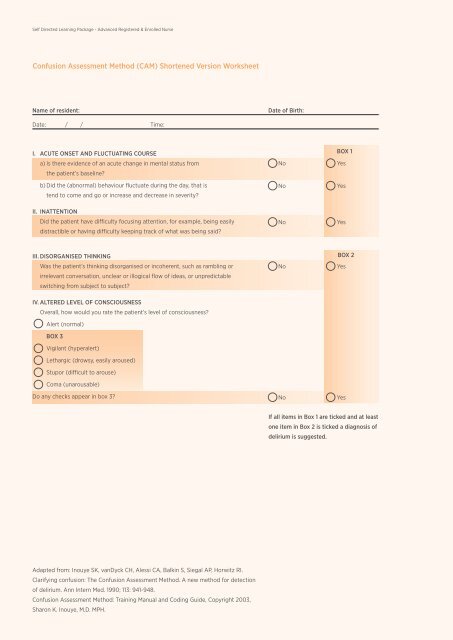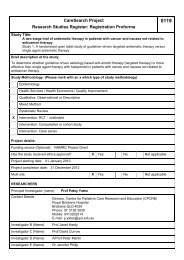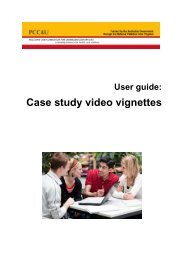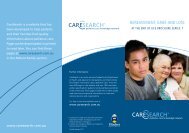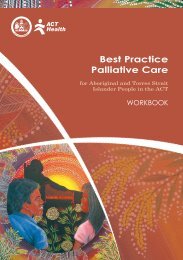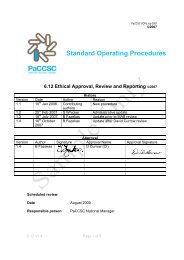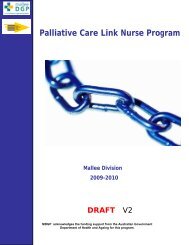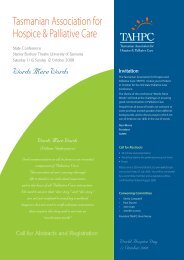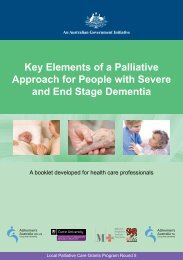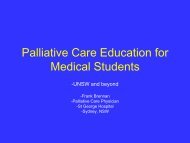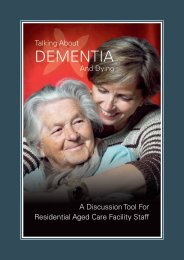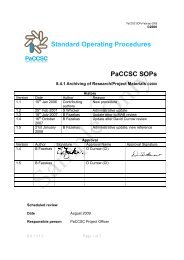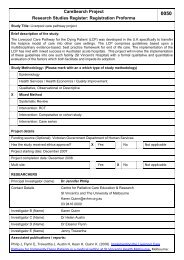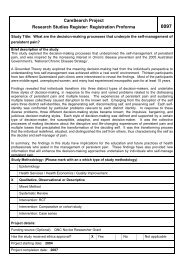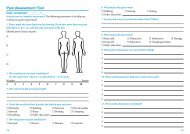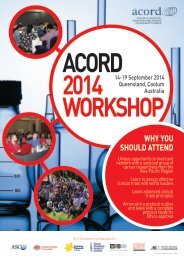Modified Bereavement Risk Index - CareSearch
Modified Bereavement Risk Index - CareSearch
Modified Bereavement Risk Index - CareSearch
Create successful ePaper yourself
Turn your PDF publications into a flip-book with our unique Google optimized e-Paper software.
Self Directed Learning Package - Advanced Registered & Enrolled Nurse<br />
Confusion Assessment Method (CAM) Shortened Version Worksheet<br />
Name of resident:<br />
Date of Birth:<br />
Date: / / Time:<br />
I. ACUTE ONSET AND FLUCTUATING COURSE<br />
a) Is there evidence of an acute change in mental status from<br />
the patient’s baseline?<br />
b) Did the (abnormal) behaviour fluctuate during the day, that is<br />
tend to come and go or increase and decrease in severity?<br />
II. INATTENTION<br />
Did the patient have difficulty focusing attention, for example, being easily<br />
distractible or having difficulty keeping track of what was being said?<br />
No<br />
No<br />
No<br />
BOX 1<br />
Yes<br />
Yes<br />
Yes<br />
III. DISORGANISED THINKING<br />
Was the patient’s thinking disorganised or incoherent, such as rambling or<br />
irrelevant conversation, unclear or illogical flow of ideas, or unpredictable<br />
switching from subject to subject?<br />
IV. ALTERED LEVEL OF CONSCIOUSNESS<br />
Overall, how would you rate the patient’s level of consciousness?<br />
Alert (normal)<br />
BOX 3<br />
Vigilant (hyperalert)<br />
Lethargic (drowsy, easily aroused)<br />
Stupor (difficult to arouse)<br />
Coma (unarousable)<br />
Do any checks appear in box 3?<br />
No<br />
No<br />
BOX 2<br />
Yes<br />
Yes<br />
If all items in Box 1 are ticked and at least<br />
one item in Box 2 is ticked a diagnosis of<br />
delirium is suggested.<br />
Adapted from: Inouye SK, vanDyck CH, Alessi CA, Balkin S, Siegal AP, Horwitz RI.<br />
Clarifying confusion: The Confusion Assessment Method. A new method for detection<br />
of delirium. Ann Intern Med. 1990; 113: 941-948.<br />
Confusion Assessment Method: Training Manual and Coding Guide, Copyright 2003,<br />
Sharon K. Inouye, M.D. MPH.
Self Directed Learning Package - Advanced Registered & Enrolled Nurse<br />
<strong>Modified</strong> <strong>Bereavement</strong> <strong>Risk</strong> <strong>Index</strong><br />
Name of Resident:<br />
Name of family member:<br />
Relationship to resident:<br />
Contact details of family member<br />
Address:<br />
Phone number: (H) (W) (M)<br />
<strong>Risk</strong> Factor<br />
Score<br />
1 Anger None 1<br />
Mild Irritation 2<br />
Moderate (occasional outbursts) 3<br />
Severe (spoiling relationships) 4<br />
Extreme (always bitter) 5<br />
2 Self Reproach<br />
(Self blame/guilt, feeling<br />
bad and/or responsible for<br />
something)<br />
None 1<br />
Mild (vague and general) 2<br />
Moderate (some clear self-reproach) 3<br />
Severe (preoccupied with self-blame) 4<br />
Extreme (major problem) 5<br />
3 Current Relationships Close intimate relationship with another 1<br />
Warm supportive family 2<br />
Family supportivve but lives at a distance 3<br />
Doubtful (patient unsure whether family members are supportive or not) 4<br />
Unsupportive 5<br />
4 How will key person cope? Well (normal grief and recovery without help) 1<br />
Fair (probably get by without specialist help) 2<br />
Doubtful (may need specialist help) 3<br />
Badly (requires specialist hellp)* 4<br />
Very badly (requires urgent help)* 5<br />
*Will be automatically referred to specialist bereavement support<br />
Total Score<br />
Low risk score (less than 7)<br />
• Give a copy of the booklet – “Now What? Understanding Grief” (a copy is included in<br />
the PA Toolkit)<br />
Moderate risk score (7-10)<br />
• Give a copy of the booklet – “Now What? Understanding Grief”<br />
• Suggest they may like to contact one of the support agencies listed in the booklet<br />
High risk score (10 or more)<br />
• Encourage the person to contact a health professional e.g. GP, psychologist,<br />
counselling service, or bereavement counsellor<br />
• Give a copy of the booklet – “Now What? Understanding Grief”<br />
Kristjanson LJ, Cousins K, Smith J, Lewin G (2005) Evaluation of the <strong>Bereavement</strong> <strong>Risk</strong><br />
<strong>Index</strong> (BRI): A community hospice care protocol . Int J of Pall Nurs. 11 (12): 610-618
Self Directed Learning Package - Advanced Registered & Enrolled Nurse<br />
Self-directed learning package:<br />
Advanced nurses quiz<br />
True<br />
False<br />
Don’t<br />
Know<br />
1 The resident and/or family must provide the nurse with information concerning their wishes about end of<br />
life care at the initial assessment and care planning interview after admission.<br />
2 There is no way of recording treatment preferences for a resident who has advanced dementia and did not<br />
record their wishes on a legal document when they still had mental capacity.<br />
3 Regular reviews of advance care plans mean checking if there is a form in the clinical records from when the<br />
resident was admitted.<br />
4 The “Understanding the Dying Process” brochure is appropriate to give to family members at a palliative<br />
care case conference.<br />
5 It is appropriate to accept a careworker estimation of the severity of a resident’s dyspnoea if they cannot<br />
remember what rating score a resident provided them.<br />
6 Attitudes and beliefs of residents, family and health professionals can be barriers to effective pain management.<br />
7 A resident with chronic pain that is moderate to severe intensity will look pale, perhaps be sweating and have<br />
changes in their heart rate and/or blood pressure.<br />
8 A tingling, burning pain that runs around one side of the chest wall between two ribs is most likely to be<br />
neuropathic in origin.<br />
9 It is up to the nurse to assess the condition of a resident’s oral health each day.<br />
10 A resident with dementia exhibits fluctuating confusion and wakefulness. This is best attributed to the<br />
dementia itself.<br />
11 Alfred has not responded to environmental and nursing interventions for his delirium. You should question<br />
the GP’s order of a dose of diazepam to help manage Alfred’s hallucinations.<br />
12 Urinary tract infections that are the cause of a delirium should always be treated.<br />
13 The GP is responsible for initiating the use of an End of Life Care Pathway when a resident is expected to die<br />
in the next week.<br />
14 A resident born in India lists their religion as Buddhist. This means that they must not be given strong<br />
analgesics or sedatives, especially at the end of life as it is important for the mind to be clear.<br />
15 If Rhonda’s <strong>Modified</strong> <strong>Bereavement</strong> <strong>Risk</strong> <strong>Index</strong> score is eleven, you only need to give her a copy of the<br />
“Now What? Understanding Grief” booklet.


